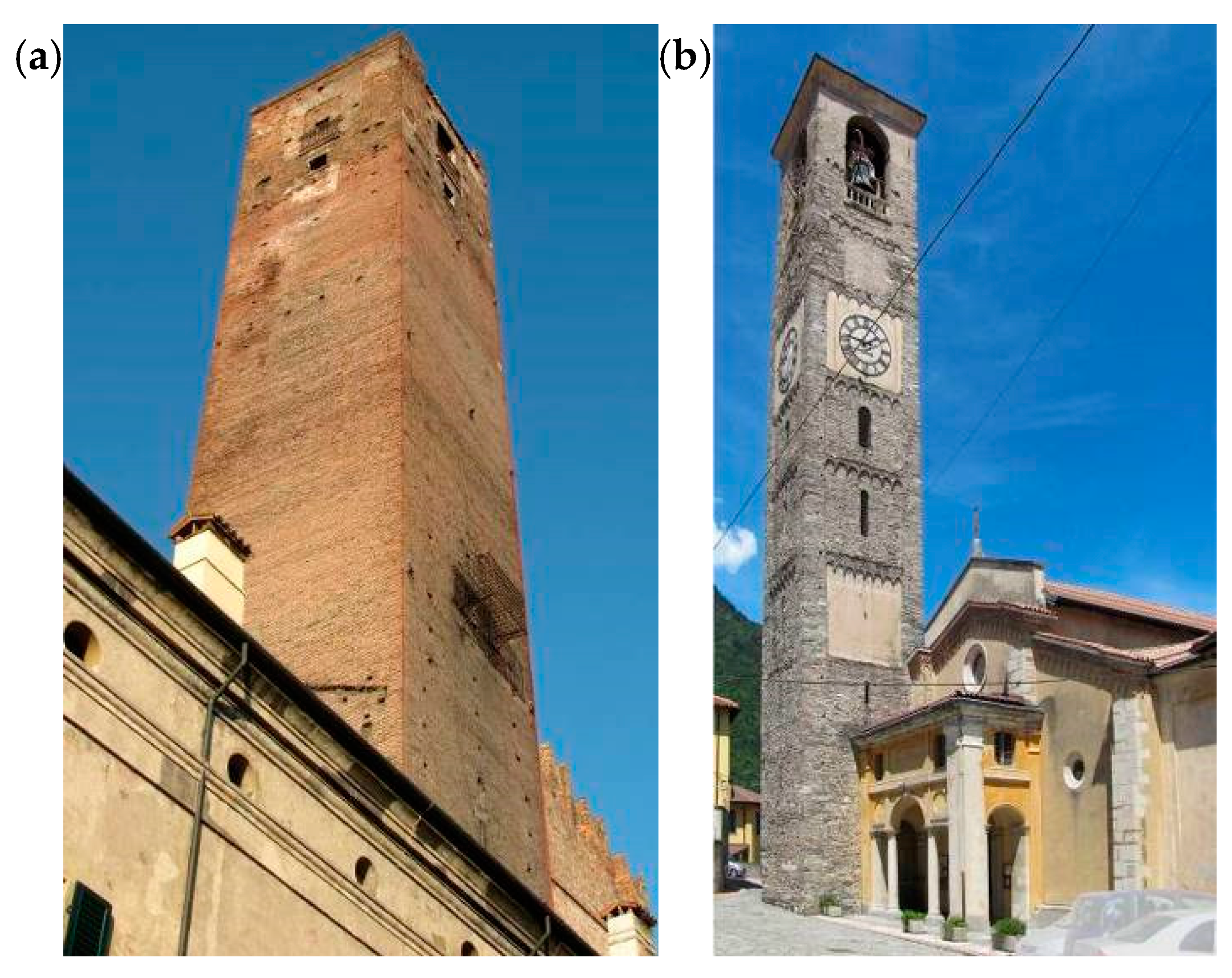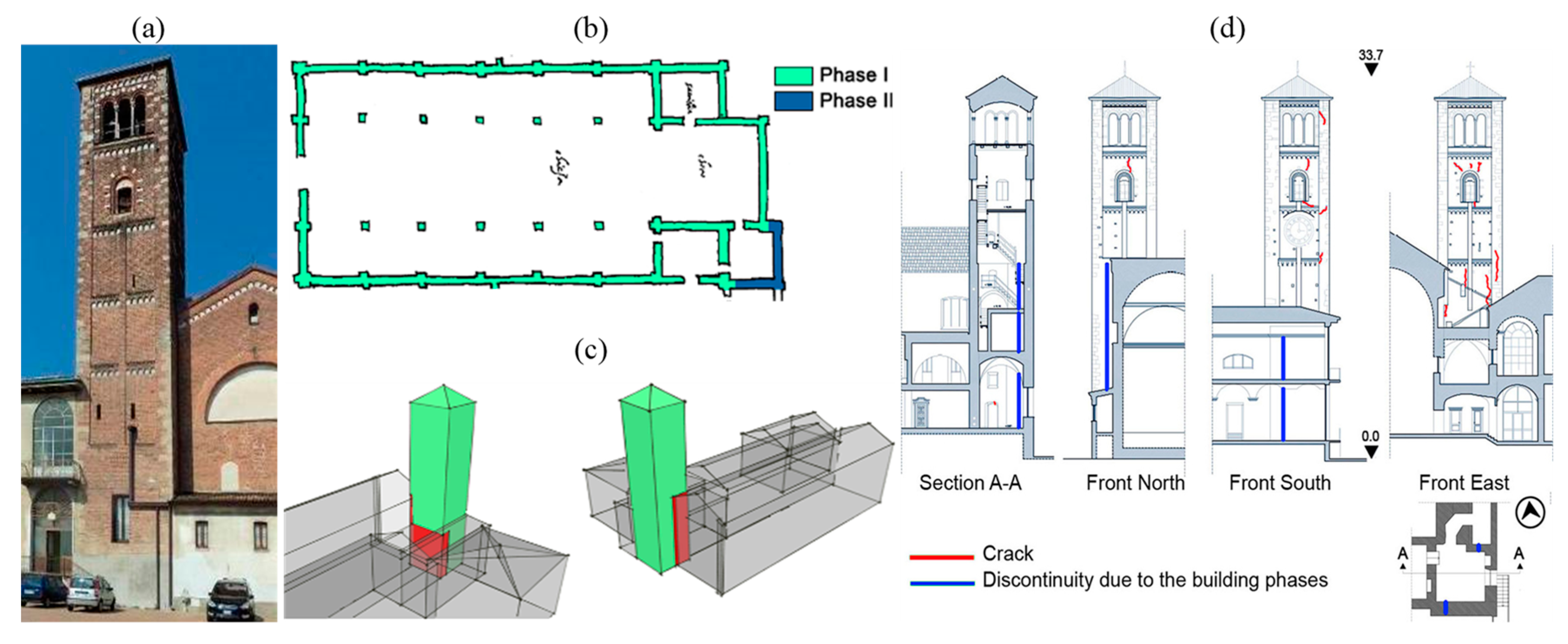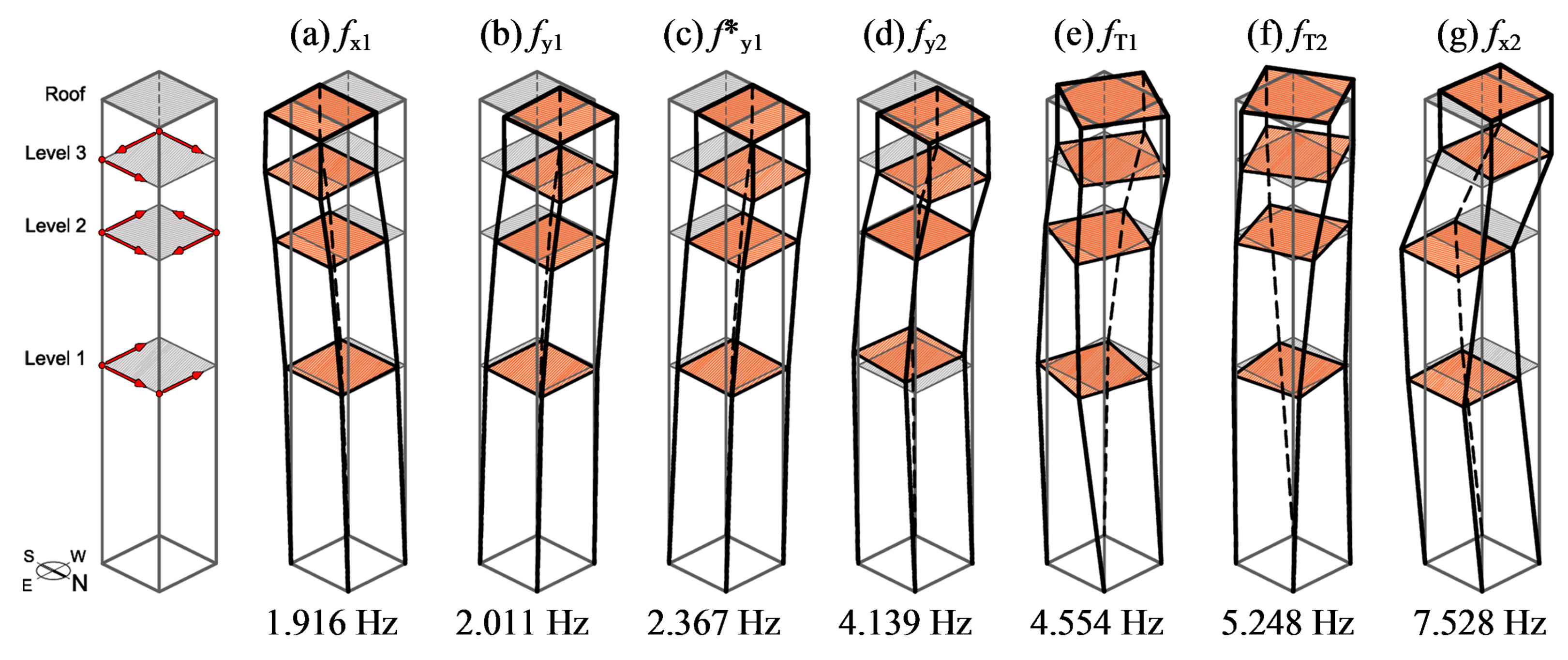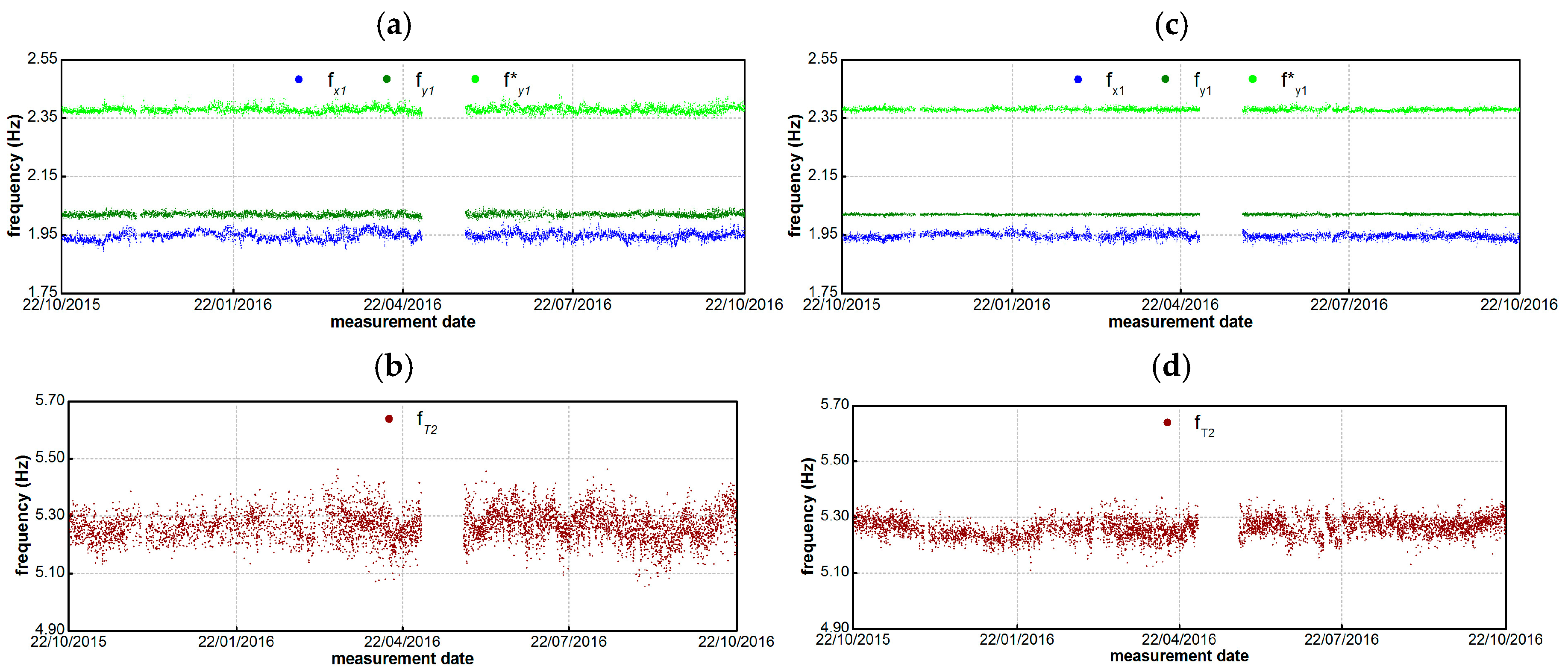Assessment of Environmental Effects for Vibration-Based Damage Detection of Historic Masonry Towers †
Abstract
:1. Introduction
2. The Influence of Environmental Changes on the Natural Frequencies of Ancient Towers
- The increase of natural frequencies with increased temperature. This behavior, observed in all studies of masonry towers [1,2,3,4,5,6] can be explained by the closure of superficial cracks and minor masonry discontinuities induced by the thermal expansion of materials. The correlation between frequency and temperature tends to be essentially linear when the temperature exceeds 10–15 °C but non linear effects are detected in the lower range of temperatures;
- Around the freezing conditions, the natural frequencies rapidly and significantly increase with decreased temperature [3,4]. This behavior is conceivably related to the freezing of the structural system (including its foundation) and to the presence of ice, which fills and closes the cracks, causing a temporary stiffening of the structure;
- Some effects of the increased temperature at the local level (such as the increase of thrust exerted by inclined structural elements [2] or the slackening of ties [4,5]) might induce significant frequency reduction (or slight overall change) with increased temperature. In the authors’ opinion, this last aspect deserves further investigation as a frequency decrease with increasing temperature could be an easy-to-evaluate symptom of an unsatisfactory state of preservation of the historic building.
3. Removal of Environmental Effects
- Notwithstanding the low level of the ambient excitation, 4 normal modes were identified with high occurrence and accuracy;
- The natural frequency of modes fx1 and fT2 exhibits significant increase in Spring and Summer period;
- On the contrary, the natural frequency of modes fy1 and f*y1 exhibits very limited variation, with the standard deviation being equal to 0.009 and 0.015 Hz, respectively. For those modes, the frequency trend increase with increased temperature is conceivably balanced by the loss of tension in the metallic tie-rod placed on the West side and connecting the North and South load-bearing walls of the tower;
- As shown in Figure 4b, the natural frequencies of the two lower modes fx1 and fy1 exhibit crossing in Summer months. To the best of the authors’ knowledge, this behavior has not been observed before on masonry towers and conceivably depends on the different effect exerted by the temperature on the natural frequencies of the two modes. Furthermore, the mode shape of both modes fx1 and fy1 tends to hybridize when crossing occurs: in other words, the two modes tend to involve biaxial bending in both the main E–W and N–S directions when the natural frequencies become very close to each other.
4. Conclusions
Author Contributions
Acknowledgments
Conflicts of Interest
References
- Ramos, L.F.; Marques, L.; Lourenço, P.B.; De Roeck, G.; Campos-Costa, A.; Roque, J. Monitoring historical masonry structures with operational modal analysis: Two case studies. Mech. Syst. Signal Process. 2010, 24, 1291–1305. [Google Scholar] [CrossRef]
- Gentile, C.; Guidobaldi, M.; Saisi, A. One-year dynamic monitoring of a historic tower: Damage detection under changing environment. Meccanica 2016, 51, 2873–2889. [Google Scholar] [CrossRef]
- Cabboi, A.; Gentile, C.; Saisi, A. From continuous vibration monitoring to FEM-based damage assessment: Application on a stone-masonry tower. Constr. Build. Mater. 2017, 156, 252–265. [Google Scholar] [CrossRef]
- Ubertini, F.; Comanducci, G.; Cavalagli, N.; Pisello, A.L.; Materazzi, A.L.; Cotana, F. Environmental effects on natural frequencies of the San Pietro bell tower in Perugia, Italy, and their removal for structural performance assessment. Mech. Syst. Signal Process. 2017, 82, 307–322. [Google Scholar] [CrossRef]
- Saisi, A.; Gentile, C.; Ruccolo, A. Continuous monitoring of a challenging heritage tower in Monza, Italy. J. Civ. Struct. Health Monit. 2018, 8, 78–90. [Google Scholar] [CrossRef]
- Azzara, R.M.; De Roeck, G.; Girardi, M.; Padovani, C.; Pellegrini, D.; Reynders, E. The influence of environmental parameters on the dynamic behaviour of the San Frediano bell tower in Lucca. Eng. Struct. 2018, 156, 175–187. [Google Scholar] [CrossRef]
- Mason, R.L.; Gunst, R.F.; Hess, J.L. Statistical Design and Analysis of Experiments with Applications to Engineering and Science; John Wiley & Sons: New York, NY, USA, 2003. [Google Scholar]
- Jolliffe, I.T. Principal Component Analysis; Springer: New York, NY, USA, 2002. [Google Scholar]





Publisher’s Note: MDPI stays neutral with regard to jurisdictional claims in published maps and institutional affiliations. |
© 2018 by the authors. Licensee MDPI, Basel, Switzerland. This article is an open access article distributed under the terms and conditions of the Creative Commons Attribution (CC BY) license (https://creativecommons.org/licenses/by/4.0/).
Share and Cite
Gentile, C.; Saisi, A. Assessment of Environmental Effects for Vibration-Based Damage Detection of Historic Masonry Towers. Proceedings 2018, 2, 441. https://doi.org/10.3390/ICEM18-05324
Gentile C, Saisi A. Assessment of Environmental Effects for Vibration-Based Damage Detection of Historic Masonry Towers. Proceedings. 2018; 2(8):441. https://doi.org/10.3390/ICEM18-05324
Chicago/Turabian StyleGentile, Carmelo, and Antonella Saisi. 2018. "Assessment of Environmental Effects for Vibration-Based Damage Detection of Historic Masonry Towers" Proceedings 2, no. 8: 441. https://doi.org/10.3390/ICEM18-05324
APA StyleGentile, C., & Saisi, A. (2018). Assessment of Environmental Effects for Vibration-Based Damage Detection of Historic Masonry Towers. Proceedings, 2(8), 441. https://doi.org/10.3390/ICEM18-05324





